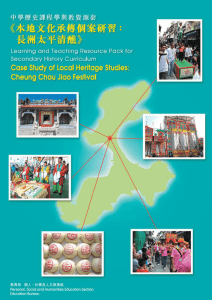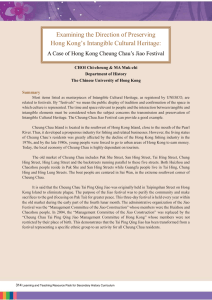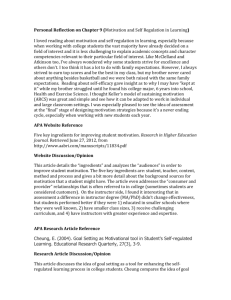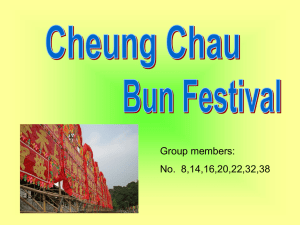Dajiao 3 3 References Eng
advertisement
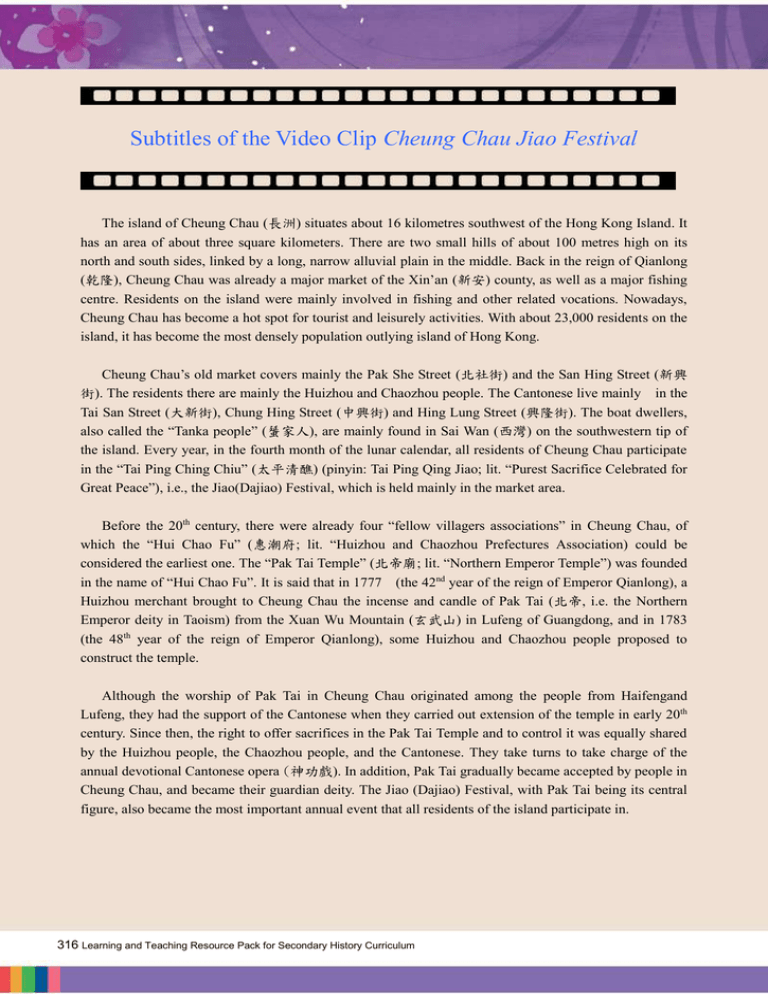
Subtitles of the Video Clip Cheung Chau Jiao Festival The island of Cheung Chau (長洲) situates about 16 kilometres southwest of the Hong Kong Island. It has an area of about three square kilometers. There are two small hills of about 100 metres high on its north and south sides, linked by a long, narrow alluvial plain in the middle. Back in the reign of Qianlong (乾隆), Cheung Chau was already a major market of the Xin’an (新安) county, as well as a major fishing centre. Residents on the island were mainly involved in fishing and other related vocations. Nowadays, Cheung Chau has become a hot spot for tourist and leisurely activities. With about 23,000 residents on the island, it has become the most densely population outlying island of Hong Kong. Cheung Chau’s old market covers mainly the Pak She Street (北社街) and the San Hing Street (新興 街). The residents there are mainly the Huizhou and Chaozhou people. The Cantonese live mainly in the Tai San Street (大新街), Chung Hing Street (中興街) and Hing Lung Street (興隆街). The boat dwellers, also called the “Tanka people” (蜑家人), are mainly found in Sai Wan (西灣) on the southwestern tip of the island. Every year, in the fourth month of the lunar calendar, all residents of Cheung Chau participate in the “Tai Ping Ching Chiu” (太平清醮) (pinyin: Tai Ping Qing Jiao; lit. “Purest Sacrifice Celebrated for Great Peace”), i.e., the Jiao(Dajiao) Festival, which is held mainly in the market area. Before the 20th century, there were already four “fellow villagers associations” in Cheung Chau, of which the “Hui Chao Fu” (惠潮府; lit. “Huizhou and Chaozhou Prefectures Association) could be considered the earliest one. The “Pak Tai Temple” (北帝廟; lit. “Northern Emperor Temple”) was founded in the name of “Hui Chao Fu”. It is said that in 1777 (the 42nd year of the reign of Emperor Qianlong), a Huizhou merchant brought to Cheung Chau the incense and candle of Pak Tai (北帝, i.e. the Northern Emperor deity in Taoism) from the Xuan Wu Mountain (玄武山) in Lufeng of Guangdong, and in 1783 (the 48th year of the reign of Emperor Qianlong), some Huizhou and Chaozhou people proposed to construct the temple. Although the worship of Pak Tai in Cheung Chau originated among the people from Haifengand Lufeng, they had the support of the Cantonese when they carried out extension of the temple in early 20th century. Since then, the right to offer sacrifices in the Pak Tai Temple and to control it was equally shared by the Huizhou people, the Chaozhou people, and the Cantonese. They take turns to take charge of the annual devotional Cantonese opera (神功戲). In addition, Pak Tai gradually became accepted by people in Cheung Chau, and became their guardian deity. The Jiao (Dajiao) Festival, with Pak Tai being its central figure, also became the most important annual event that all residents of the island participate in. 316 Learning and Teaching Resource Pack for Secondary History Curriculum There are various legends regarding the origin of the Jiao(Dajiao) Festival in Cheung Chau. Huizhou people of the older generation recalled that the Jiao(Dajiao) Festival of Cheung Chau originated in the Tai Ping Shan Street (太平山街) on Hong Kong Island. In about the end of 19th century, due to the bubonic plague, residents on the Tai Ping Shan Street held the “Tai Ping Ching Chiu” rituals that centred around Pak Tai in order to avert calamities and release dead souls from suffering. Later, they moved the event to the Pak She Street of Cheung Chau, which was also inhabited by the Haifeng and Lufeng people. Each year, the Jiao(Dajiao) Festival is held for three days in the early part of the fourth month of the lunar calendar. By convention, Taoist ritual masters ( Taoist priests 喃嘸師傅) from Hailufeng (i.e. Haifeng and Lufeng) are employed to conduct the rituals. On the day before the Jiao(Dajiao) period, poles with streamers are erected to confirm the boundary of Jiao(Dajiao) area, to which the deities are then invited to come. The residents then clean the neighborhood with water. In the evening, the ritual masters carry out rituals such as “purifying the altar” (淨壇) and “consecration” (開光). Before midnight, the altar is set and opened (啟壇), which signifies the commencement of the Jiao event. During the Jiao(Dajiao) period, the Taoist ritual masters perform the Jiao(Dajiao) rituals (醮儀) every morning, afternoon and evening on behalf of the residents by saying repentance to the deities and requesting them to forgive the villagers for the sins they have committed. As a fishing community, marine safety is extremely important to Cheung Chau. Therefore, the ritual of “feeding the water ghosts” (祭水幽) is performed on the second evening for the sake of feeding dead souls and relieving them from suffering. At the same time, the “welcome the sacred ones” (迎聖) ritual is performed inside the bamboo sheds for making offerings, and the Jade Emperor and various deities are invited to enjoy the items for sacrificial offering. On the third morning, the “sending off the flower boats” (遣船) ritual is performed by the Taoist ritual masters, who order the paper merit-recording envoy to send paper boats that symbolize dirty things and ducks that represent “bad luck” to the sea, thus signifying the removal of impurity and bad luck. The next is “distributing talismans” (頒符), a process in which the Taoist ritual masters hand out to the residents sheets of paper with magic characters written in cock blood as charms to ensure their safety. In midday of this third day, the Composite-scene Parade (會景巡遊) takes place. Led by Pak Tai, deities of other temples, and the Taoist ritual masters, the procession parade within the Jiao (Dajiao) area to placate evil ghosts and eradicate diseases. During the night, the “great offering to the wandering spirits” (祭大幽) is held, during which the Taoist ritual masters offer sacrifice to wandering spirits on behalf of the residents and salvage them from the underworld with their supernatural power. After the ritual has ended, the Ghost King (大士王) is sent off by burning his effigy. “Great offering to the wandering spirits” is the climax of the annual Jiao (Dajiao) rituals. The buns on the bun towers (包山) can bring safety because the Taoist ritual masters have chanted scriptures and exercised magic power on them. When this “great offering to the wandering spirits” ritual is over, the residents will rush forward to “snatch buns on the bun towers” (搶包山). The next day, a second Composite-scene Parade is held, during which the deities are sent back to various temples. By tradition, the Hailufeng Bai Zi opera (Hoklo Opera 海陸豐白字戲) is performed. The Jiao (Dajiao) Festival officially ends when the opera ends. Case Study of Local Heritage Studies: Cheung Chau Jiao Festival • Teachers’ References 317 In addition to the traditional Hailufeng folk Taoist rituals, there are various traditional folk performing arts, such as “ Parade of floats” (飄色), qilin dance, lion dance, paper craft, and Cantonese opera. There is also bun-snatching on bun towers, an event unique of Cheung Chau. All these are demonstrated in the Jiao(Dajiao) Festival each year. Regarding folk crafts, the making of the paper items needed in the Jiao(Dajiao) Festival have always been done by craft masters from the Hailufeng region. The most important paper craft items are the three giant deity statues of Ghost King, the Earth God (土地公) and the Mountain God (山神), which are about five metres tall. The three 18-metre-tall giant bun towers are indispensible in the Cheung Chau Jiao(Dajiao) Festival. The bun towers have always been built by the Hailufeng people on the island. They make use of traditional folk craft and build the tall bun towers with bamboo poles and China Fir. ([Mr. CHAN-lam(陳 林) / bun tower building craft master] Interview with craft master CHAN-lam with fifty years of bun tower building experience: 30 seconds. 22:00 – 22:11 and 22:41 – 23:04. “When making the bun towers, the materials are moved to here first. I’ll start work today. First, I’ll go to worship Pak Tai, and begin work after that”. “After erecting the bun towers, we’ll paste paper (on the bamboo structure), then we’ll place the buns on the structure. After that, the Taoist ritual masters will do the consecration by chanting scriptures in front of the bun towers. The building process is complete when the chanting finishes.” (Interview with CHAN Kam-yun (陳金源), son of craft master CHAN-lam , 10:20 – 10:37. “I’ve seen dad do the craft for several decades. He is so willing to do this traditional craft. Seeing that he’s become old, and wishing that the craft would pass on to younger generations, I try my best to learn it, in the hope of keeping it.” The craft has lost its economic benefits. The three generations of the Chan family keep passing it on mainly out of their sense of identity to the community they belong to. They feel responsible for contributing to the preservation such a unique cultural tradition of Cheung Chau. The original intention of Composite-scene Parade is to clean up the community by having Pak Tai leading various deities and Taoist priests to patrol the region. What made “fluttering colours” (colour floats) emerge in later days? (Interview with Mr. CHEUNG Chik-fan (張植芬), the craft master who made the “floats” of Nan She (南社), 01:42 – 02:07. “If there was just the god worshipping rituals in the Jiao (Dajiao) Festival, the mood of the streets would be much less lively. So, to make the Jiao (Dajiao) event appear more important and the kaifongs pay more attention to it, the residents started to hold some events to cheer up the atmosphere. At the beginning, there was only the lion dance. We didn’t yet think of “floats”). In early 20th century, residents of the Pak She and Nam She went to Foshan in Guangdong to learn making fluttering colours (colour floats), and they introduced fluttering colours (colour floats) into the Composite-scene Parade of the Jiao (Dajiao) Festival. This will enhance its attractiveness. Now, the Composite-scene Parade has become a key event for tourists spectators of the Jiao (Dajiao) Festival. 318 Learning and Teaching Resource Pack for Secondary History Curriculum (Interview with Mr. LEE Kin-ting (李見定), Deputy Executive Director of the Pak She Street Kaifong Association, 19:40 – 20:04. “The parade brings people together. Even those (Cheung Chau residents who have moved to) in Hong Kong will return to Cheung Chau. This is cohesion; the power of cohesion. At the same time, this is my street, to which I have a sense of belonging. I want the “ floats” from this street to be the most beautiful. In that case I can show off around.” 20:56 – 20:03 “I’m persistent. I hope these young people would participate, so that this event will continue .” (Interview with Professor CHOI Chi-cheung (蔡志祥), Department of History, Chinese University of Hong Kong, 01:40. “An important point about the Jiao (Dajiao) Festival of Cheung Chau is that it is a festivity that has been held each year for more than a century without interruption. The festival comprises various folk customs and religious performing arts. Most importantly, it unites all residents in Cheung Chau into a unity. It is a very important festival. Why do we say that it is facing a crisis? The reason is simple. We don’t know how it’s changing. Culture and folk customs are bound to change. If we just see its current condition, we won’t know what changes it undergoes, and what remains unchanged. Therefore, under such circumstances, I think what we need to do is to conserve this process of change by recording it with various media, texts and images. Only then are we able to know what this important festivity that unites Cheung Chau is, and how it has transformed into its current form. Only then can this cultural heritage be preserved.”) In the 1970s, along with the decline of Hong Kong’s fishing industry. many Cheung Chau residents chose to move to make a living in the urban area. In the 1980s, Hong Kong’s industry moved northwards as the mainland of China carried out its reform and opening-up. As a result, small-scale industry on the island also disappeared. When the residents of Cheung Chau insist on organizing the Jiao (Dajiao) Festival annually in order to maintain their local culture, they are inevitably confronted with the predicament of shortage of resources and reduction in scale of the event and the rituals. (Interview with Mr. YUNG Chi-ming (翁志明), Chairman of the Cheung Chau Committee, 05:18 – 05:31. “During those days it was very difficult to organize the Jiao (Dajiao) Festival. People couldn’t make a living, and they had to leave Cheung Chau to work. It was hard for them to take leave and come back to Cheung Chau.” Entering the 21st century, the government inscribed traditional festive events onto the list of key development items for the sake of developing tourism in Hong Kong. (Interview with Dr. TING Sun-pao (丁新豹), former Chief Curator of the Hong Kong Museum of History, 1:30. Now people talk about the Jiao (Dajiao) Festival (in Cheung Chau) as if it comprises only activities such as the Composite-scene Parade and the bun towers. Therefore, what we should concern about is to introduce the features of this event to those who go to visit it, and how it is related to the Cheung Chau community. We must make these clear to people, so that they know the meaning behind the event when they enjoy seeing it. At the same time, the event is a tradition of over a hundred years. It is indeed a very precious intangible cultural heritage of Hong Kong.) Case Study of Local Heritage Studies: Cheung Chau Jiao Festival • Teachers’ References 319
